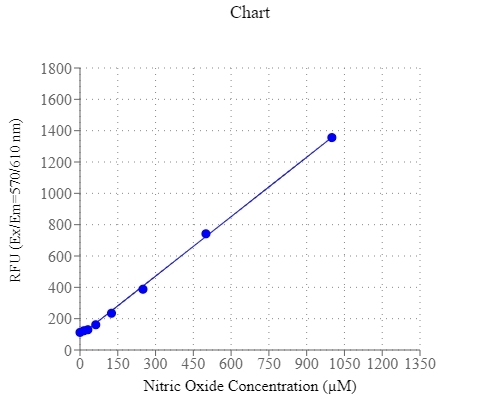Amplite® Fluorimetric Extracellular Nitric Oxide (NO) Activity Assay Kit
Nitric oxide (NO) is an important biological regulator involved in numbers of physiological and pathological processes. Altered NO production is implicated in various immunological, cardiovascular, neurodegenerative and inflammatory diseases. As a free radical, NO is rapidly oxidized and there is relatively low concentrations of NO existing in biological systems. It has been challenging to detect and understand the role of NO using conventional tools. AAT Bioquest offers a group of NO assay kits for monitoring NO in live cells. This Amplite® Extracellular Fluorimetric Nitric Oxide Quantitation Kit provides a rapid method to monitor NO level in extracellular media, tissues, and other biological solutions and samples. Compared to the commonly used DAF-2 probe, DAW-J2 is used as the cell-impermeant NO sensor in our kit 16365. DAW-J2 detects nitric oxide exclusively in the extracellular environment with high sensitivity and selectivity. The non-fluorescent DAW-J2 probe reacts with NO to generate a strongly red fluorescent product that can be conveniently monitored using a microplate reader.


| Catalog | Size | Price | Quantity |
|---|---|---|---|
| 16365 | 100 Tests | Price |
Storage, safety and handling
| H-phrase | H303, H313, H333 |
| Hazard symbol | XN |
| Intended use | Research Use Only (RUO) |
| R-phrase | R20, R21, R22 |
| Storage | Freeze (< -15 °C); Minimize light exposure |
| UNSPSC | 12352200 |
Instrument settings
| Fluorescence microplate reader | |
| Excitation | 570 nm |
| Emission | 610 nm |
| Cutoff | 590 nm |
| Recommended plate | Solid black |
Contact us
| Telephone | |
| Fax | |
| sales@aatbio.com | |
| International | See distributors |
| Bulk request | Inquire |
| Custom size | Inquire |
| Technical Support | Contact us |
| Request quotation | Request |
| Purchase order | Send to sales@aatbio.com |
| Shipping | Standard overnight for United States, inquire for international |
Page updated on December 21, 2025
